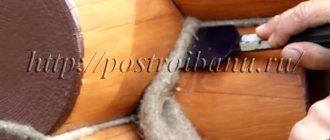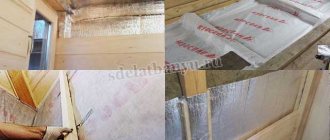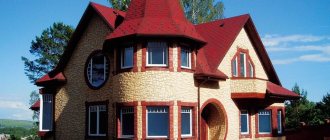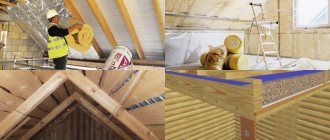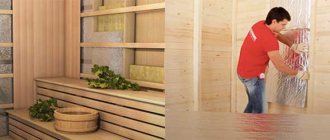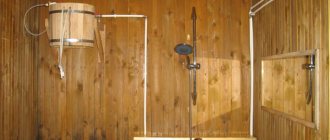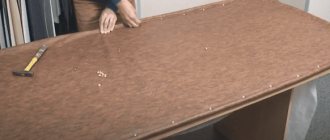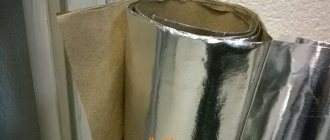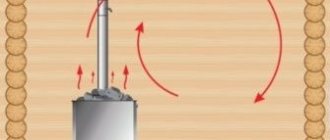Insulating the roof of a bathhouse is an important task, the correct implementation of which determines the temperature and humidity in the steam room and other rooms of the bathhouse. First of all, for proper insulation of the bathhouse roof, it is important to decide whether the bathhouse will have an attic floor or a ventilated attic. The sequence and choice of materials for insulating the roof of a bathhouse largely depends on this.
Bathhouse roof insulation
There are two main stages of thermal insulation of the roof in a bathhouse: insulation of the ceiling of the steam room and dressing room and insulation of the roof slopes. The feasibility of the second stage for a bathhouse with an unheated and well-ventilated attic is very controversial - if the temperature in the attic is close to the street temperature, there will be no problem of condensation, and therefore rotting of wooden structures. Therefore, in a bathhouse with a cold attic, the roof slope is usually not insulated - this is a waste of money. Ventilation is provided by installing attic windows, and the attic itself is used for drying and storing brooms and other necessary items.
When insulating the roof of a bathhouse with an attic floor, it is necessary to insulate both the ceiling and the roof slope. This will make it possible to arrange a full-fledged recreation room on the second floor. In such a bathhouse, it is necessary to pay close attention to the vapor barrier of the floors in order to avoid an increase in humidity on the second floor. Otherwise, the principles of insulating a bathhouse roof are no different and are performed using similar technology.
Methods
Insulation of the attic floor in the bathhouse must be done in any case. It is this element that is the last line that traps heat inside and prevents the penetration of cold air. There are three methods of thermal insulation - hemming, flooring, panel.
Grazing
A simple method that is suitable for inexperienced builders. To complete it you need a small amount of building materials. Floor ceilings cannot be installed in rooms whose width exceeds 2.5 meters. The flooring should rest only on load-bearing walls, and not partitions.
Laying features:
- The maximum distance between load-bearing walls is 2.5 meters.
- The minimum thickness of the boards is 50 mm. They must be of high quality, free from cracks, knots, and rot.
- Before nailing the boards, they need to be sanded and coated with an antiseptic.
Flooring assembly process:
- Attach the prepared boards to the wall beams.
- Lay a vapor barrier film and attach it with a stapler.
- Lay mineral wool in rolls or slabs.
You can make homemade insulation - sew flat bags from waterproof fabric, fill them with padding polyester, foam rubber, red moss or dry pine needles.
When installing a floor ceiling, the attic cannot be used as a room.
Hemmed
Build process:
- Cut the lumber to the required size, correct any unevenness, and coat it with a protective antiseptic.
- Since stove equipment that runs on solid fuel is often installed in bathhouses, it is necessary to consider the location of the chimney. Install a special sleeve in the selected location. You can make it yourself from metal sheets or buy a finished product at a hardware store.
- Secure the vapor barrier film over the ceiling beams. Fix the individual sheets overlapping each other, with an overlap of 10 cm. It is recommended to seal the seams with metal tape.
- Hem the ceiling with pre-treated boards.
- Secure the foil insulation, which is nailed down with slats.
- On top of the vapor barrier film, which runs along the ceiling beams, make a wooden frame from 50x50 mm bars.
- Insert mineral wool slabs into the sections.
- Install a vapor barrier membrane. Cover it with slats to create a ventilated gap.
You can fix the lining on top of the slats.
Panel
Build process:
- Panel thermal insulation involves the assembly of a massive panel. Its base is two beams measuring 50x100 mm.
- Place the bars on the floor in front of you, leaving a distance of 50 cm between them. Align the edges in one straight line.
- Prepare the boards, cut them 60 cm long. One edge should protrude 50 cm. It is important to choose boards of the same thickness (25–30 mm).
- Make a shield.
- Attach a vapor barrier film to the inside of the structure.
- Place mineral wool on top of the film, tightly to each other.
Several such panels need to be prepared to insulate the entire ceiling. The finished structures are laid out on top of the last crown. The modules are connected by jumpers. They are attached to the crown with self-tapping screws.
On top of the finished flooring, it is necessary to lay another layer of vapor barrier and fill the slats to create a ventilation gap.
Types of insulation for ceilings and roofs
When choosing insulation for a bathhouse roof, you need to take into account its technical characteristics. The material must be resistant to moisture.
Styrofoam
These are foam plates or granules that are made in different ways. Thanks to this, the required performance characteristics can be achieved.
Advantages of polystyrene foam:
- ease;
- ease of installation;
- durability;
- low price;
- resistance to moisture.
Flaws:
- The material is highly flammable.
- Polystyrene foam does not allow moisture to pass through itself. This leads to the accumulation of condensation inside the bath rooms.
On sale you can find varieties of polystyrene foam, during the production of which various modifiers are added. They reduce the flammability of the material.
Extruded polystyrene foam
It is similar to polystyrene foam, but other technologies are used in its production. The finished product is obtained with increased performance characteristics.
Advantages:
- high strength;
- resistance to chemicals;
- environmental friendliness;
- immunity to moisture;
- ease of installation;
- low specific gravity.
The disadvantages are similar to polystyrene foam.
Penoizol
One of the types of polystyrene foam, which belongs to cast-in thermal insulators. Since penoizol does not accumulate moisture, condensation does not form inside the walls. Penoizol is immune to high temperatures.
Flaws:
- release of harmful substances when heated;
- complex installation.
Not the best type of insulation for baths. It is relevant to use for industrial and utility premises.
Minvata
A common material for insulating baths and residential buildings. Made from natural ingredients.
The basis is molten rocks, to which synthetic substances are added.
Advantages:
- ease of installation;
- chemical resistance;
- low flammability of the material;
- removal of water vapor without delay;
- immunity to temperature changes;
- low thermal conductivity.
Flaws:
- Mineral wool loses its technical properties when exposed to moisture for a long time.
- When heated strongly, it releases harmful substances.
- The mass of the material is greater than that of polystyrene foam.
Mineral wool is used for insulation of industrial equipment, highways, networks, suspended facades, ceilings, walls, floors, wet facades.
Ecowool
Shredded waste paper with a reduced flammability index. When mixed with water, it produces a sticky mass that can be used to cover various surfaces.
Advantages:
- high level of noise absorption;
- environmental friendliness;
- resistance to high temperatures;
- economical consumption;
- ease of installation.
After application, a homogeneous layer without joints or seams is obtained. The manufacturer claims that fungus and mold do not form on the surface of ecowool.
Expanded clay
A porous, lightweight material that is made by firing shale or clay. Advantages:
- high thermal insulation rate;
- ease of installation;
- low specific gravity;
- low flammability;
- environmental friendliness;
- durability;
- resistance to household chemicals.
Flaws:
- When laying granules horizontally, you need to use a special substrate.
- To prevent the material from getting wet during operation, it is necessary to lay an additional layer of waterproofing.
To create a high-quality insulation layer, expanded clay is poured in a layer of at least 15 cm. This reduces the free space.
Vermiculite
A complex mineral that consists of magnesium, silicon, aluminum, and iron. Thanks to this, a multilayer structure of crystals is obtained. Advantages:
- environmental friendliness
- good vapor permeability;
- resistance to the formation of fungus and mold;
- no shrinkage;
- low thermal conductivity.
To prevent moisture from accumulating, ventilation gaps must be left.
Other types of insulation
More often, clay is used to insulate the roof and other surfaces in the bathhouse. It can be found on the territory of any summer cottage, but it is important to remember that clay is heavy. When insulating the ceiling, clay must be mixed with sawdust or other lightweight material.
Which insulation is better?
The choice of insulation is influenced by a number of factors:
- financial opportunities;
- design features of the ceiling, roof;
- necessary technical specifications.
When choosing a thermal insulation material, you need to take into account a number of rules:
- It must be environmentally friendly so as not to emit harmful substances when heated strongly.
- Rot, mold, and fungus should not form on the surface.
- The material should not be destroyed by rodents or insects.
- The insulation should not be destroyed at high temperatures.
- Thermal insulation must be strong and durable.
For thermal insulation outside
The best options for thermal insulation materials for external surfaces:
- Styrofoam;
- liquid thermal insulation;
- mineral wool;
- polyurethane foam.
For thermal insulation from the inside
Thermal insulation materials for interior decoration:
- Styrofoam;
- mineral wool;
- ecowool.
Mineral wool
A general name for a group of insulation materials with similar properties. To insulate the ceiling you can use:
- Glass wool, which is made from glass fibers. Slag wool, made from blast furnace slag. Rock wool, made from molten rocks.
Their common advantages include low thermal conductivity, good resistance to temperature changes and fire resistance. The average service life of materials is 40-50 years, which is due to their high resistance to rotting and the proliferation of pathogenic microflora. The main disadvantages are the loss of insulating properties even when slightly wet and the fragility of the fibers, which leads to heavy dusting.
Comparative characteristics of mineral wool are presented in the table
Variety Thermal conductivity coefficient Fiber length, mm Possibility of combustion Glass wool 0.04215-50 Absent Slag wool 0.0416 Sintered at high temperature Stone wool 0.04616 Absent
Cotton insulation is produced in the form of slabs and rolls. The first ones are more convenient to install. Some manufacturers produce foil coatings, which is very convenient, since the metallized layer reflects heat rays and retards evaporation.
Features of thermal insulation depending on the type of roof
The principle of insulation depends on the design of the roof in the bathhouse. Therefore, you first need to study the specifics of the work.
Single-pitch
Features of insulation of a pitched roof:
- The basis for installing thermal insulation is the rafter system. It is also the supporting foundation of the entire roof.
- A vapor barrier film is only needed over heated rooms.
- Thermal insulation is a “pie” consisting of hydro-, heat- and vapor insulation.
It is important to leave a ventilation gap to prevent moisture from accumulating under the roof.
Gable
Features of gable roof insulation:
- For two slopes, it is better to use polystyrene foam, since it is easier to work with.
- When insulating a gable roof, you need to use polyurethane foam, which can be purchased in liquid form.
Example of roof insulation
The need for insulation
The territory of Russia is located mostly in temperate and northern latitudes, where frost reigns in winter, so all heated structures are insulated. The bathhouse has a complex microclimate: on the one hand, it is very hot, and on the other, humid. To “lock” the heat inside, insulating materials with low thermal conductivity are mounted on the inner or outer surface of the slope. Thanks to this measure, a complex of problems is solved at once:
- Heat loss. The air in a heated room moves according to the laws of convection, that is, heated gas rises upward, giving way below for colder gas. Since the bathhouse is constantly maintained at a high temperature, heat loss through an uninsulated roof will be significant.
- Formation of condensation. In a bathhouse, where you cannot do without a large amount of water, the air is humid and saturated with water vapor. When it rises to the roof and comes into contact with rafters, floor beams or roofing materials that have a relatively low temperature, condensation droplets form. Cold liquid falling on steamed bodies and hot heads is an unpleasant surprise that is best eliminated.
- High fuel consumption. Now that firewood is not cheap, a lot of money is spent on heating the bathhouse well. An insulated roof optimizes energy costs by preventing heat from leaving the heated room for longer, resulting in less fuel being spent on maintaining the optimal temperature.
- Protecting the roof from damage. The heat from the interior heats the snow cap lying on the slope in winter. Because of this, ice layers form, which, sliding off the roof, damage the roofing.
Important! If the bathhouse has a single-pitched or double-pitched roof, and the attic space is not used as a storage space, then, according to experienced builders, you can not insulate the slopes, but will limit yourself to high-quality insulation of the ceiling.
Bathroom ceiling insulation
What does thermal insulation consist of?
Proper thermal insulation is a layered “pie”. Each layer is responsible for separate functions.
Waterproofing
A hydrobarrier that protects the base from exposure to hot steam and moisture. Polymer-based film is used as waterproofing. Installation:
- Cover the ceiling on the attic side with slats and form a frame.
- Secure a waterproofing film between the beams. A construction stapler is used for this.
In order for accumulated water to be removed from under the roof, the film must be brought to the overhangs of the roofing material.
Thermal insulation
Features of installation of the thermal insulation layer:
- For insulation you need to make a ventilation gap. Thanks to it, condensation will disappear and moisture will not accumulate.
- Mineral wool and polystyrene foam must be laid in two layers.
- You can secure the mineral wool slabs between the rafters using a stretched fishing line.
Where the insulation joins the chimney, the pipe must be covered with a layer of asbestos.
Vapor barrier
To protect the insulation from steam penetration, film membranes are used. The film itself is attached to a stapler. Individual sheets should overlap each other with an overlap of 10 cm. It is recommended to glue the joints with metal tape.
Expanded clay of various fractions
Environmentally friendly insulation, available in the form of clay granules of various sizes. The advantages of the material are:
- low thermal conductivity; fire resistance; immunity to high humidity; resistance to mold and fungi.
Among the disadvantages of expanded clay, it should be noted that it is necessary to backfill a sufficiently high layer of insulation, which can lead to an increase in the weight of the floor.
In addition, the top layer of granules is capable of absorbing water, especially if the technology was violated during the production process. Wet material loses its insulating properties and takes a very long time to dry. Therefore, the presence of hydro- and vapor barrier is necessary.
Carrying out work
Any person without extensive experience in construction work can do the insulation of a bathhouse roof with his own hands. Initially, you need to prepare consumables and tools.
Materials and tools
List of required materials and tools:
- slats, bars for sheathing;
- insulation, waterproofing film, vapor barrier membrane;
- metal tape;
- construction stapler;
- sharp knife;
- nails, hammer or screwdriver with self-tapping screws;
- jigsaw, wood saw;
- Sander.
Additionally, you will need a protective antiseptic for wood and wide brushes for applying it.
Preparation
Preparatory work:
- Cut the bars and slats to the required sizes in advance.
- Sand the lumber and correct any unevenness.
- Coat the wood with an antiseptic to protect it from rot, mold, and mildew.
There is no need to cut the insulation in advance. It is better to do this after filling the sheathing.
Thermal insulation outside
The process of arranging external thermal insulation:
- Secure the vapor barrier layer over the ceiling beams using a stapler.
- Stuff the wooden sheathing from the bars.
- Place insulation in the empty sections.
- Lay a layer of waterproofing.
- Secure the slats on top of which the facing material can be attached.
Thermal insulation from the inside
Features of insulating the roof of a bathhouse from the inside with foam plastic:
- It is recommended to fasten the boards with special glue.
- There is no need to fill the sheathing with bars.
Features of working with glass wool:
- The waterproofing film must be attached tightly to the glass wool.
- In order for the insulation to hold, you need to build a structure from wooden beams.
- It is necessary to attach cotton wool to the outside of the sheathing only if it is solid.
- If the sheathing is arranged in sections, glass wool should be placed between the rafters.
Errors and recommendations
Recommendations for insulating the roof of a bathhouse:
- In the place where the chimney passes through the roof, only non-combustible substances can be used. It is recommended to cover the pipe itself with bricks or seal it with asbestos.
- To ensure high-quality thermal insulation, you must comply with all rules and regulations. For example, waterproofing must be laid in two layers - one will protect the insulation from moisture from the street, the other from water vapor from the steam room.
- Dormer windows need to be installed in the attic. They are needed to ventilate the attic space.
- The thermal insulation layer should not sag.
- For cold climate zones, the insulation should be laid in two layers.
- Attics must be insulated at the ceiling and floor.
If the waterproofing or vapor barrier film breaks, it is necessary to apply an additional layer on top of it.
It is important to choose the right insulation so that it retains heat, allows steam to pass through, and does not emit harmful substances when heated strongly. It is important not to skimp on vapor and waterproofing.
Scat
It is also recommended to insulate it.
The technology for insulating the slope is similar to that used for the roof. You can use foam or fiber insulation for this work. The work can be done before or after the roofing is laid.
During the event, you should ensure that materials that could catch fire are kept at a considerable distance from the chimney. There you need to build a metal box and fill it with non-flammable substances.
